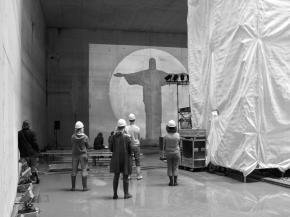Claudia Sola
dal 10/4/2008 al 8/5/2008
Segnalato da
10/4/2008
Claudia Sola
Stedelijk Museum Bureau SMBA, Amsterdam
Screens on 11: 60 DAYS (fall-winter)s. The speed with which the photo and film fragments flash means that they are hardly readable, but you recognise them nevertheless, like words in a sentence. Found footage is combined with material the artist has shot herself, old photos run together with contemporary pictures. Her images are arranged in a grid, and this structure determines the compelling visual cadence.

The speed with which the photo and film fragments flash by in the work of Claudia Sola means that they are hardly readable, but you recognise them nevertheless, like words in a sentence. The quantity of images dazes one; their separate sizes vary, as does the rhythm with which they appear. Found footage is combined with material the artist has shot herself, old photos run together with contemporary pictures. Her images are arranged in a grid, and this structure determines the compelling visual cadence.
Sola refers to the gaping chasm between the omnipresent, universal visual language and the particular histories that are often ignored. Where she appropriated the visual vocabulary of cinema for that purpose in Trick 'r Treat (2002) and Klaas Vaak (2002), recently she has recycled the language of press photography. The often intense images show upraised arms and kissing people, but also anonymous signs with place names, birthday cakes, muscled torsos and scars. Just as in the media, joy and sorrow unabashedly stand side by side. A raging forest fire merges into a glowing, setting sun. Only the visual similarities remain on the retina of the unsuspecting viewer who, befuddled by all the images, fails to consider the disaster with which he or she is confronted (Being There, 2007). The rhythm is the driving force behind the individual images from which the films are assembled, and is further reinforced by the expressive soundtracks composed by Sola herself. It is to this apparently repetitive mechanism that the films owe their effect, but perhaps more important yet is the exceptional image quality: no ugly thumbnails randomly gleaned off the net and blown up to film screen proportions, but each and every one high resolution photographs.
In her multi-layered work Sola appeals to the viewer's emotional involvement, while at the same time confirming his or her zapping behaviour with the varying tempo and multiplicity of the images. Children draw water in 101 Days (2007), children pray, pee, dance, protest, fight, eat, play, sleep, film. In this way the child becomes an icon, like the figure of Christ that appears with equal frequency in art-historical tradition. The origin and original significance of the symbol – whether it is Jesus, or Che Guevara or the V-for-Victory sign – is often forgotten. Sola reminds us of it. As the camera slowly zooms out at the end of 101 Days, we see that a girl's head has been circled on an old class photo. The image stands still, and disappears. These motionless photos, which refer to moments from a personal history, are the points of anchorage for the films.
They function as visual madeleines, just as the cake dipped in tea takes the central figure in Proust's magnum opus back to a time past. Not only life's joys and sorrows, but also the various times here stand alongside one another. But the sweet taste of Proust's madeleine is absent from Sola's work. She proceeds from the realisation that no image is innocent, not even one of the setting sun. A photograph or film fragment brings unexpected moments to the surface, and plays a game with reality without contradicting it. You create an image yourself, from diverse scraps and fragments. In Claudia Sola's work each person tells their own story, just as each image does.
Claudia Sola (b. Zeist, 1974) studied at the Gerrit Rietveld Academy and De Ateliers. The work which she made as a result of a commission from the Stedelijk Museum Bureau Amsterdam is to be seen on the panoramic video screens of Club 11 in the Post CS-Building from April 11 through May 9 from 9-10 p.m., as part of the Screens on 11 programme.
Text by Ilse van Rijn
Stedelijk Museum Bureau
Rozenstraat 59 - Amsterdam



